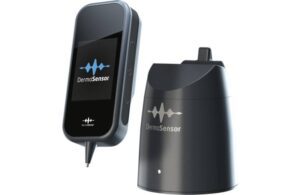
DermaSensor today presented data from two clinical studies supporting its non-invasive device for evaluating suspicious skin lesions.
Miami, Florida-based DermaSensor’s handheld device uses a form of optical spectroscopy called elastic scattering spectroscopy (ESS). It takes noninvasive samples of tissue, capturing cellular-level information. The technology uses hundreds of wavelengths of light in a manner similar to how sonar uses sound.
DermaSensor’s device received FDA breakthrough device designation and is currently under review by the agency.
Pooled analysis came from the DERM-ASSESS III and DERM-SUCCESS clinical studies. DermaSensor presented results at the American Academy of Dermatology (AAD) 2023 Annual Meeting.
Data demonstrated 94% sensitivity for correctly classifying 338 high-risk lesions and 23% specificity for correctly classifying 1,681 low-risk lesions. All lesions were biopsied by physicians under suspicion of skin cancer.
Miami, Florida-based DermaSensor said in a news release that its device met its primary endpoints in the DERM-SUCCESS pivotal study. It defined one primary endpoint as having higher sensitivity than primary care physicians (PCPs) for all common skin cancers.
“DermaSensor’s technology will help primary care physicians detect cancerous skin lesions and refer those patients appropriately to a dermatologist,” said Dr. Jane Grant-Kels, who served as last author on this AAD publication of these studies and is a Professor and founding Chair emeritus of the Department of Dermatology at the University of Connecticut (UConn) Health Center and Medical School. “Prompt referral from a PCP to a dermatologist can help minimize patient mortality, morbidity and result in the saving of health care dollars.” Dr. Grant-Kels is the 2023 recipient of the Clarence S. Livingwood, MD, Memorial Award and Lectureship from the AAD and is a member of DermaSensor’s Scientific Advisory Board.
More on the data from DermaSensor
A total of 32 study centers biopsied more than 2,000 suspicious lesions across both studies. At 10 centers in the DERM-ASSESS-III study, findings showed a 96% device sensitivity for detecting melanoma in the dermatology setting. The same study demonstrated 91% sensitivity for all high-risk melanocytic lesions. It classified 32.5% of benign lesions (specificity) biopsied under suspicion of melanoma.
DermaSensor said a negative device result registered a 98% chance of proving negative for melanoma. A positive device result presented melanoma approximately one out of six times. This demonstrated a higher risk for melanoma with a positive device result and therefore a recommendation to the physician to refer that patient to a dermatologist.
Similarly, the DERM-SUCCESS study across 22 primary care study centers demonstrated 96% device sensitivity for all skin cancers in the primary care setting. Specificity came in at 21% for correctly classifying benign lesions biopsied by physicians. Like the DERM-ASSESS-III study, one in six lesions with a positive device result proved cancerous.
Neither study reported device-related safety issues. The study included investigators and authors from Mayo Clinic, Harvard School of Medicine, Yale School of Medicine, University of Connecticut, Florida State University, Trinity University, and the Medical College of Georgia.
“It is an honor to have been selected to present data at the AAD from our two major clinical validation studies, which are two of our four studies serving as principal support for our FDA submission,” said DermaSensor CEO Cody Simmons. “Having spent a decade miniaturizing and conducting studies with our spectroscopy technology, we hope to soon equip PCPs in the U.S. with our handheld, wireless device in order to improve their detection and referral of skin cancer, which is more common than all other cancers combined.”